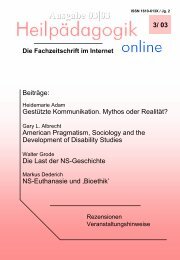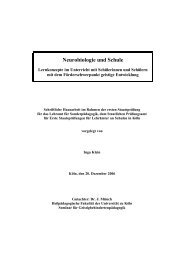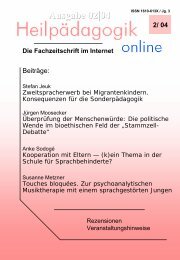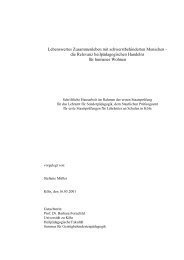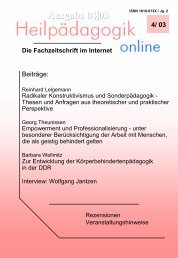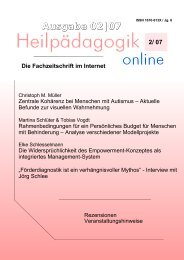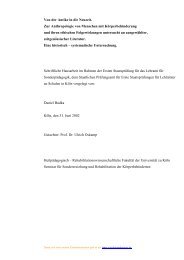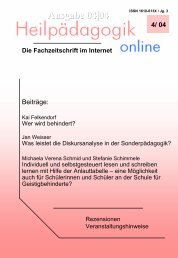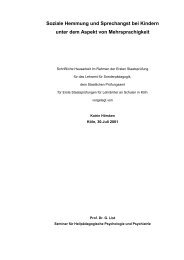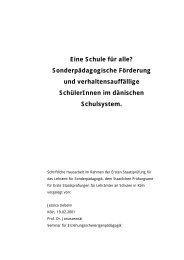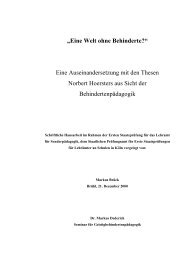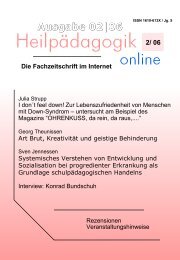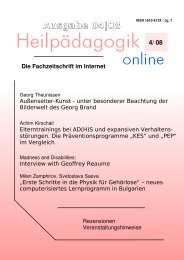Hochbegabung und Sonderpädagogik - sonderpaedagoge.de!
Hochbegabung und Sonderpädagogik - sonderpaedagoge.de!
Hochbegabung und Sonderpädagogik - sonderpaedagoge.de!
Erfolgreiche ePaper selbst erstellen
Machen Sie aus Ihren PDF Publikationen ein blätterbares Flipbook mit unserer einzigartigen Google optimierten e-Paper Software.
Twice exceptional<br />
GAGNÉ, F. (2005). From gifts to talents. The DMGT as a <strong>de</strong>velopmental<br />
mo<strong>de</strong>l. In R. J. STERNBERG & J. E. DAVIDSON (Eds.),<br />
Conceptions of giftedness (2nd ed., 98-119). New York, NY:<br />
Cambridge University Press.<br />
GOERTZEL, V. & GOERTZEL, M. G. (1962). Cra<strong>de</strong>ls of eminence.<br />
Boston, MA: Little, Brown.<br />
HACKNEY, P. W. (1986). Education of the visually handicapped<br />
gifted: A program <strong>de</strong>scription. Education of the Visually Handicapped,<br />
18(2), 85-95.<br />
HELLER, K. A., PERLETH, C. & LIM, T. K. (2005). The Munich<br />
mo<strong>de</strong>l of giftedness <strong>de</strong>signed to i<strong>de</strong>ntify and promote gifted<br />
stu<strong>de</strong>nts. In R. J. STERNBERG & J. E. DAVIDSON (Eds.), Conceptions<br />
of giftedness (2nd ed., 147-170). New York, NY: Cambridge<br />
University Press.<br />
HENDERSON, L. M. (2001). Asperger's syndrome in gifted individuals.<br />
Gifted Child Today, 24(3), 28-35.<br />
HOWELL, K. W., EVANS, D. & GARDINER, J. (1997). Medications<br />
in the classroom: A hard pill to swallow? Teaching Exceptional<br />
Children, 29(6), 58-61.<br />
ISaR Projekt <strong>de</strong>r Technischen Universität Dortm<strong>und</strong> (2009). Lernmaterialdatenbank<br />
<strong>de</strong>s ISaR-Projekts (Integration von Schülerinnen<br />
<strong>und</strong> Schülern mit einer Sehschädigung an<br />
Regelschulen). Retrieved January 26, 2009, from<br />
http://www.isar-projekt.<strong>de</strong>/material/material.php<br />
KADOSH, R. C. & WALSH, V. (2007). Dyscalculia. Current Biology,<br />
17(22), 946-947.<br />
KAPLAN, S. N. (1986). The grid: A mo<strong>de</strong>l to construct differentiated<br />
curriculum for the gifted. In J. S. RENZULLI (Ed.), Systems<br />
and mo<strong>de</strong>ls for <strong>de</strong>veloping programs for the gifted and<br />
talented (180-193). Mansfield Center, CT: Creative Learning<br />
Press.<br />
KING, E. W. (2005). Addressing the social and emotional needs of<br />
twice-exceptional stu<strong>de</strong>nts. Teaching Exceptional Children,<br />
38(1), 16-20.<br />
LIND, S. & SILVERMAN, L. K. (1994). ADHD or gifted? Un<strong>de</strong>rstanding<br />
our Gifted, 6, 13-16.<br />
LITTLE, C. (2001). A closer look at gifted children with disabilities.<br />
Gifted Child Today, 24(3), 46-64.<br />
LITTLE, C. (2002). Which is it? Asperger's syndrome or giftedness?<br />
Defining the differences. Gifted Child Today, 25(1), 58-<br />
63.<br />
LOVECKY, D. V. (1994). Gifted children with attention-<strong>de</strong>ficit disor<strong>de</strong>r.<br />
Un<strong>de</strong>rstanding our Gifted, 6(5), 7-10.<br />
LUPART, J. & TOY, R. (in press). Twice-exceptional: Multiple pathways<br />
to success. In L. SHAVININA (Ed.), International Handbook<br />
on Giftedness (3rd ed.). Hei<strong>de</strong>lberg: Springer.<br />
- 85 -<br />
Heilpädagogik online 02/ 09



